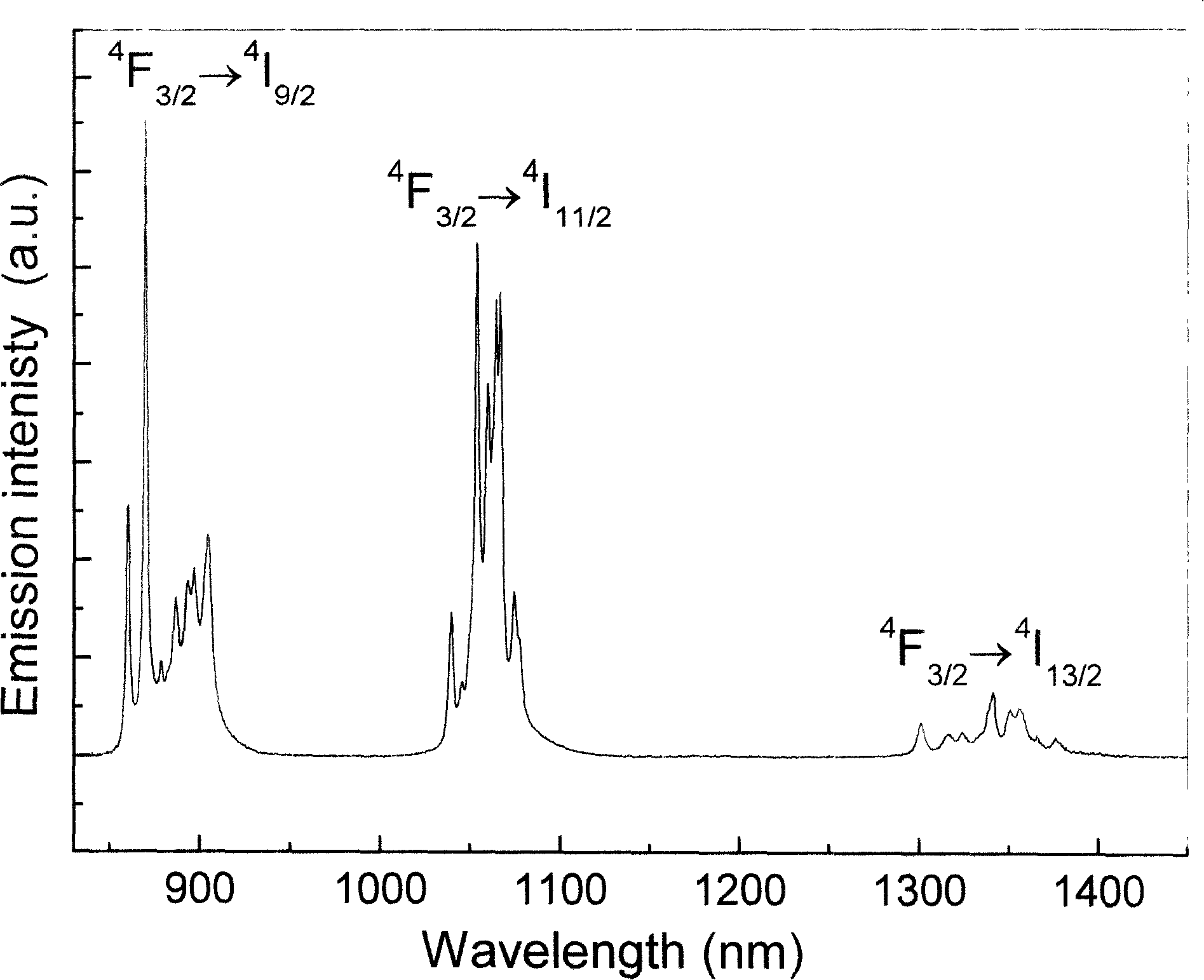Neodymium-doped yttrium-fluoride nanocrystalline transparent glass ceramic with high stimulated emission cross section and preparation thereof
A technology of stimulated emission and neodymium yttrium fluoride is applied in the field of neodymium-doped glass ceramics and its preparation technology, which can solve the problems of reducing industrial application value and the like, and achieve the effects of stable structure, low cost and low equipment requirements.
- Summary
- Abstract
- Description
- Claims
- Application Information
AI Technical Summary
Problems solved by technology
Method used
Image
Examples
example 1
[0010] Example 1: Analytical pure SiO 2 、Al 2 o 3 , LiF, YF 3 and NdF with a purity of 99.99% 3 Powder, according to 2.0NdF 3 : 44SiO 2 : 28Al 2 o 3 :10LiF:16YF 3 (Molar ratio) is accurately weighed and placed in an agate mortar, ground for more than half an hour to make it evenly mixed, then placed in a platinum crucible, heated to 1400°C in a program-controlled high-temperature box-type resistance furnace, and then kept for 1.5 hours , and then, quickly pour the glass melt into a preheated copper mold at 300°C for forming; put the obtained glass into a resistance furnace, anneal at 500°C for 2 hours and then cool with the furnace to eliminate internal stress; the annealed glass After holding at 570° C. for 2 hours, a blue transparent glass-ceramic doped with 2.0% neodymium ions was obtained. Transmission electron microscopy studies have shown that there are a large number of YF with a size of 20-30nm in the glass ceramics 3 The grains are evenly distributed in the ...
example 2
[0011] Example 2: Analytical pure SiO 2 、Al 2 o 3 , LiF, YF 3 and NdF with a purity of 99.99% 3 Powder, according to 1.0NdF 3 : 44SiO 2 : 28Al 2 o 3 :10LiF:17YF 3 The proportioning ratio of (molar ratio) was accurately weighed, and after the same preparation and heat treatment process as in Example 1, a blue transparent glass-ceramic doped with 1.0% neodymium ions was obtained. After the sample is surface polished, the emission spectrum at room temperature is measured with a FLS920 fluorescence spectrometer. After calculation, 1 f 3 / 2 → 1 I 11 / 2 The stimulated emission cross section of the transition is 7.83×10 -20 cm 2 , the luminous quantum efficiency is 78%.
example 3
[0012] Example 3: Analytical pure SiO 2 、Al 2 o 3 , LiF, YF 3 and NdF with a purity of 99.99% 3 Powder, according to 0.1NdF 3 : 44SiO 2 : 28Al 2 o 3 : 10LiF : 17.9YF 3 The proportioning ratio of (molar ratio) was accurately weighed, and after the same preparation and heat treatment process as in Example 1, a light blue transparent glass-ceramic doped with 0.1% neodymium ions was obtained. After the sample is surface polished, the emission spectrum at room temperature is measured with a FLS920 fluorescence spectrometer. After calculation, 4 f 3 / 2 → 4 I 11 / 2 The stimulated emission cross section of the transition reaches 15.53×10 -20 cm 2 , the luminous quantum efficiency reaches 95%.
PUM
 Login to View More
Login to View More Abstract
Description
Claims
Application Information
 Login to View More
Login to View More - R&D
- Intellectual Property
- Life Sciences
- Materials
- Tech Scout
- Unparalleled Data Quality
- Higher Quality Content
- 60% Fewer Hallucinations
Browse by: Latest US Patents, China's latest patents, Technical Efficacy Thesaurus, Application Domain, Technology Topic, Popular Technical Reports.
© 2025 PatSnap. All rights reserved.Legal|Privacy policy|Modern Slavery Act Transparency Statement|Sitemap|About US| Contact US: help@patsnap.com

